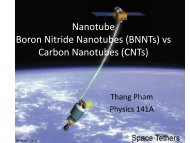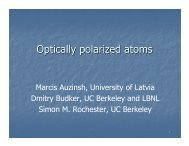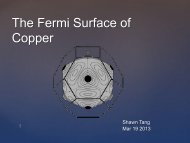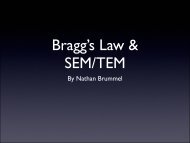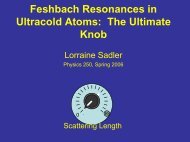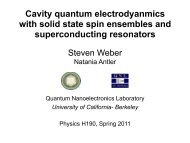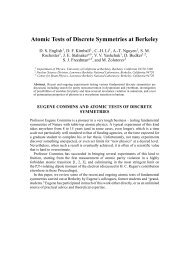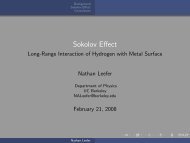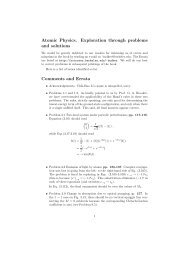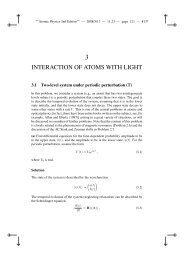Resonant nonlinear magneto-optical effects in atomsâ - The Budker ...
Resonant nonlinear magneto-optical effects in atomsâ - The Budker ...
Resonant nonlinear magneto-optical effects in atomsâ - The Budker ...
You also want an ePaper? Increase the reach of your titles
YUMPU automatically turns print PDFs into web optimized ePapers that Google loves.
7<br />
(Barkov and Zolotorev, 1980; Roberts et al., 1980).<br />
Magneto-<strong>optical</strong> rotation, <strong>in</strong> particular, the concept of<br />
forward scatter<strong>in</strong>g, was also applied <strong>in</strong> analytical spectroscopy<br />
for trace element detection. This was first done<br />
by Church and Hadeishi (1974), who, us<strong>in</strong>g FS signals,<br />
showed sensitivity an order of magnitude higher than<br />
could be obta<strong>in</strong>ed with absorption measurements. <strong>The</strong><br />
improved sensitivity of <strong>magneto</strong>-<strong>optical</strong> rotation compared<br />
to absorption is due to almost complete elim<strong>in</strong>ation<br />
of background light and a correspond<strong>in</strong>g reduction of its<br />
<strong>in</strong>fluence on the signal noise. Such noise is the ma<strong>in</strong> limitation<br />
of the absorption techniques. Follow<strong>in</strong>g this work,<br />
Ito et al. (1977) also employed both Faraday and Voigt<br />
<strong>effects</strong> for trace analysis of various elements.<br />
<strong>The</strong> detection of weak transitions by <strong>magneto</strong>-<strong>optical</strong><br />
rotation (with applications to molecular and analytical<br />
spectroscopy) was spectacularly advanced by employment<br />
of lasers. Us<strong>in</strong>g tunable color-center lasers, Litf<strong>in</strong><br />
et al. (1980) demonstrated 50 times better sensitivity <strong>in</strong><br />
detection of NO transitions <strong>in</strong> the vic<strong>in</strong>ity of 2.7 µm with<br />
<strong>magneto</strong>-<strong>optical</strong> rotation compared to absorption spectroscopy.<br />
Similar results were obta<strong>in</strong>ed by Yamamoto<br />
et al. (1986) who obta<strong>in</strong>ed 200-fold enhancement <strong>in</strong> sensitivity<br />
over absorption spectroscopy <strong>in</strong> their work with<br />
a pulsed dye laser and the sodium D2 l<strong>in</strong>e. Another <strong>in</strong>terest<strong>in</strong>g<br />
result was reported by H<strong>in</strong>z et al. (1982) who<br />
worked <strong>in</strong> the mid-<strong>in</strong>frared range with NO molecules<br />
and a CO laser. <strong>The</strong>se authors also demonstrated that<br />
<strong>magneto</strong>-<strong>optical</strong> rotation improves sensitivity <strong>in</strong> either of<br />
the basic configurations, i.e., <strong>in</strong> the Faraday as well as the<br />
Voigt geometry.<br />
<strong>The</strong> advent of high-sensitivity laser spectropolarimeters,<br />
allow<strong>in</strong>g measurement of <strong>optical</strong> rotation at the level<br />
of 10 −8 rad and smaller (Sec. XI.B), made possible the<br />
sensitive detection of species with low concentration. 6 It<br />
is important to note that, while it is beneficial from the<br />
po<strong>in</strong>t of view of the photon shot noise of the polarimeter<br />
to operate at a high light power, great care should<br />
be taken to make sure that the atoms of <strong>in</strong>terest are not<br />
bleached by <strong>nonl<strong>in</strong>ear</strong> saturation <strong>effects</strong> (Sec. III.B). As<br />
a practical way to optimize a trace analysis setup, we<br />
suggest the use of a buffer gas to pressure-broaden the<br />
homogenous width of the transition up to the po<strong>in</strong>t when<br />
this width becomes comparable to the Doppler width.<br />
This way, the l<strong>in</strong>ear absorption and Faraday rotation are<br />
not compromised, but the light <strong>in</strong>tensity constra<strong>in</strong>ts due<br />
to <strong>nonl<strong>in</strong>ear</strong>ities are relaxed by many orders of magnitude.<br />
Due to its high sensitivity, the <strong>magneto</strong>-<strong>optical</strong> rotation<br />
method can also be applied to the study of<br />
weak transitions, such as magnetic dipole transitions<br />
with small transition magnetic moments (Barkov et al.,<br />
1989b).<br />
2. Measurement of oscillator strengths<br />
Fork and Bradley III (1964) performed some of the<br />
earliest work <strong>in</strong> which resonant <strong>magneto</strong>-<strong>optical</strong> rotation<br />
was used to measure oscillator strengths. 7 <strong>The</strong>y<br />
measured dispersion of Hg vapor at about five Doppler<br />
widths from the center of the 253.7-nm l<strong>in</strong>e. <strong>The</strong>y used<br />
an electrodeless discharge 198 Hg lamp placed <strong>in</strong> a solenoid<br />
as a light source tunable over eight Doppler widths and<br />
measured the vapor dispersion us<strong>in</strong>g a Mach-Zehnder <strong>in</strong>terferometer.<br />
In addition to the observation of Faraday<br />
rotation <strong>in</strong> excess of 7 rad, they also demonstrated the<br />
<strong>in</strong>version of the sign of the dispersion of a vapor with<br />
<strong>in</strong>verted population, and the feasibility of us<strong>in</strong>g Faraday<br />
rotation for narrow-band modulatable <strong>optical</strong> filters.<br />
<strong>The</strong> advent of tunable lasers has enabled significant improvement<br />
of <strong>magneto</strong>-<strong>optical</strong>-rotation methods for measur<strong>in</strong>g<br />
absolute and relative oscillator strengths. This is<br />
illustrated by the results, shown <strong>in</strong> Fig. II.B, of an experiment<br />
performed by Gawlik (1975). Here curves (a) and<br />
(b) refer to a FS experiment performed with a sodium<br />
spectral lamp and a Lyot filter that selected one of the<br />
Na D l<strong>in</strong>es. <strong>The</strong> light from the lamp had an asymmetric<br />
spectral profile with some self-reversal (a l<strong>in</strong>e-profile<br />
perturbation due to re-absorption of resonance light at<br />
the l<strong>in</strong>e center) and FWHM of about 8 GHz. From the<br />
results for the D1 and D2 l<strong>in</strong>es, one can see how the modulation<br />
period depends on the product of atomic density<br />
and oscillator strength of the <strong>in</strong>vestigated transitions and<br />
how the oscillatory birefr<strong>in</strong>gent contribution (Fig. II.C.2)<br />
becomes overwhelmed by the structureless dichroic one,<br />
particularly at small magnetic fields. Figures II.B (c) and<br />
(d) represent results from the same experiment but with,<br />
<strong>in</strong> place of a lamp, a narrow-band cw dye laser tuned to<br />
the centers of gravity of the Na D1 and D2 l<strong>in</strong>es, respectively<br />
(Gawlik, 1977; Gawlik et al., 1979). Several important<br />
changes are seen: first, the modulation depth is now<br />
100%—this allows accurate determ<strong>in</strong>ation of ϕ(nl, ω, B),<br />
where ω is the light frequency (Fig. II.C.2); second, the<br />
dichroic contribution can be fully elim<strong>in</strong>ated by appropriately<br />
tun<strong>in</strong>g the laser (this is because the dichroic effect<br />
has a nearly dispersive spectral dependence which goes<br />
through zero when the Faraday rotation contribution is<br />
nearly maximal); third, as seen by the envelope of the oscillatory<br />
pattern, total absorption exp [−(A + + A − )ωl/c]<br />
plays a role only for small B, <strong>in</strong> agreement with the above<br />
considerations [see Figs. II.B(c) and (d)]. Fast oscillation<br />
<strong>in</strong> the region of low total absorption makes it possible<br />
to determ<strong>in</strong>e the absorption profile (envelope) simultaneously<br />
with the measurement of ϕ. This technique allows<br />
one to simultaneously determ<strong>in</strong>e the real and imag<strong>in</strong>ary<br />
parts of the complex <strong>in</strong>dex of refraction, which is useful<br />
for measur<strong>in</strong>g collisional parameters, for example.<br />
6 Detection of on the order of hundreds of particles per cubic centimeter<br />
was reported by Vasilenko et al. (1978).<br />
7 Early measurements of oscillator strength are described <strong>in</strong> a<br />
monograph by Mitchell and Zemansky (1971).





